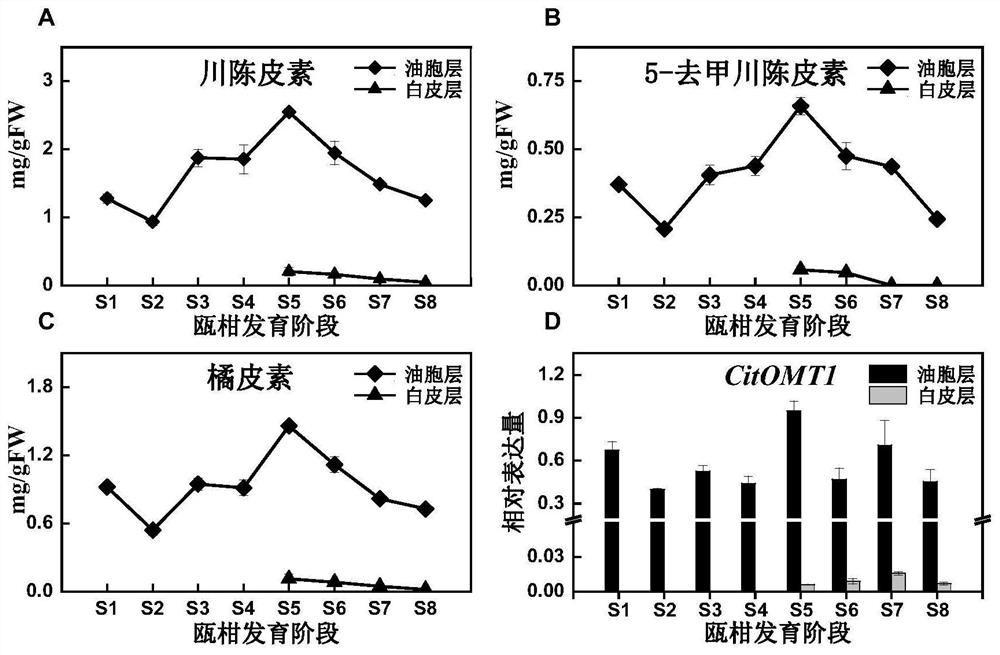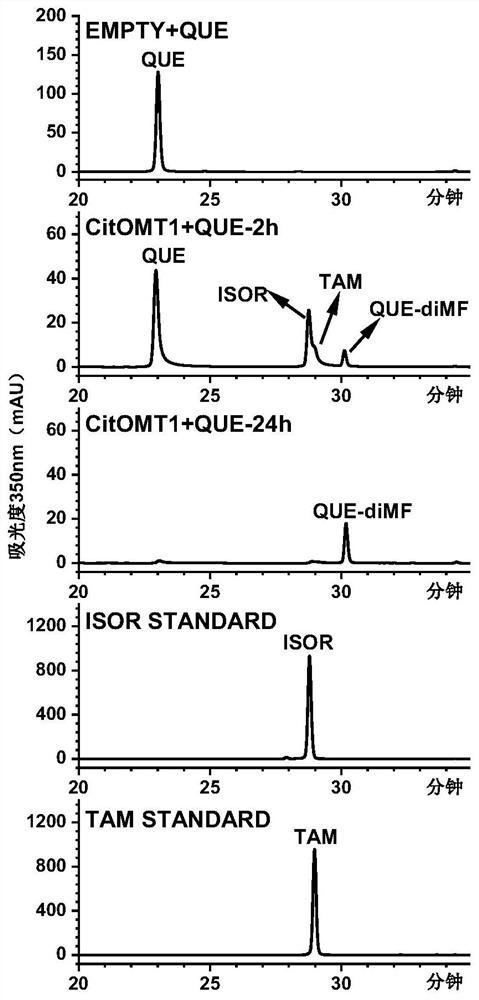Oxymethyltransferases involved in the synthesis of flavonoids in citrus peel and their coding genes and applications
A technology of oxymethyltransferase and methylation, applied in the field of oxymethyltransferase CitOMT1 and its coding gene and application, to achieve high application value and research prospects, and the effect of simple enzyme activity reaction conditions
- Summary
- Abstract
- Description
- Claims
- Application Information
AI Technical Summary
Problems solved by technology
Method used
Image
Examples
Embodiment 1
[0025] Example 1: Cloning of the CitOMT1 gene
[0026] (1) Experimental method
[0027] Gene cloning: CitOMT1 was obtained by BLAST analysis of the reported Arabidopsis thaliana OMT gene and the Citrus Genome Database (http: / / www.citrusgenomedb.org / ), and the nucleotide sequence is SEQ: No. 2. Combining the primer pairs of SEQ: No.3 and SEQ: No.4, using the cDNA of Ou mandarin fruit oil cell layer as a template, PCR amplification was carried out with reference to FastStart High Fidelity PCR System (Roche), wherein the PCR system was: 10×Buffer 3μL, dNTP 2.4 μL, 1.2 μL of upstream and downstream primers (10 μM), 0.3 μL of enzyme, 21.3 μL of DEPC-treated water, 0.6 μL of cDNA; PCR program: pre-denaturation at 95 °C for 5 min; denaturation at 95 °C for 30 sec, annealing at 58 °C for 30 sec, 72 °C Extension for 1 min, 35 thermal cycles; extension for 1 min at 72, and storage at 4°C. The PCR products were recovered by 1% agarose gel electrophoresis and then connected to pGEM-T Ea...
Embodiment 2
[0030] Example 2: Analysis of the expression pattern of CitOMT1 in the developmental stage of Ou mandarin
[0031] (1) Experimental method
[0032] 1. Fruit material collection
[0033] Ou mandarin fruits at different developmental stages were used as materials. Picked at 30(S1), 60(S2), 80(S3), 100(S4), 120(S5), 140(S6), 170(S7), 200(S8) days after full bloom, divided into 3 Biological repetitions, 8 fruits were picked for each repetition; the pericarp of Ou mandarin was divided into two parts: oil cell layer and white cortex, cut into small pieces, quickly placed in liquid nitrogen, and then stored at -80°C.
[0034] 2. Analysis of flavonoids by high performance liquid chromatography (HPLC)
[0035] Weigh 0.5 g of the sample powders of the oil cell layer and white cortex of the pericarp of Ou citrus peel, ultrasonically use 3 mL of 80% ethanol for 30 min, centrifuge the extract (4000 rpm, 10 min), repeat three times, and combine the supernatant (about 9 mL) for the flavon...
Embodiment 3
[0044] Example 3: In vitro functional identification of CitOMT1 enzyme activity
[0045] (1) Experimental method
[0046] 1. Construction of recombinant vectors and recombinant cells
[0047] Using the verified primer pairs of SEQ:No.3 and SEQ:No.4, plus the restriction sites BamHI, XhoI and protective bases of pET32a, new primer pairs SEQ:No.10 and SEQ:No.11 were constructed. Using the sequence-verified CitOMT1-T vector as a template, combined with PCR technology, the open reading frame of CitOMT1 was cloned and loaded into the pET32a vector to construct a CitOMT1-pET recombinant expression vector, which was introduced into E. coli expression strains by heat shock method In BL21 (DE3) pLysS (Promega), the bacterial solution was evenly spread on LB plates containing 100 μg / mL ampicillin (Amp) to screen positive single colonies, and stored at -80°C with 20% glycerol for later use.
[0048] 2. Induction and purification of CitOMT1 protein
[0049] After inoculation and activa...
PUM
| Property | Measurement | Unit |
|---|---|---|
| molecular weight | aaaaa | aaaaa |
Abstract
Description
Claims
Application Information
 Login to View More
Login to View More - R&D
- Intellectual Property
- Life Sciences
- Materials
- Tech Scout
- Unparalleled Data Quality
- Higher Quality Content
- 60% Fewer Hallucinations
Browse by: Latest US Patents, China's latest patents, Technical Efficacy Thesaurus, Application Domain, Technology Topic, Popular Technical Reports.
© 2025 PatSnap. All rights reserved.Legal|Privacy policy|Modern Slavery Act Transparency Statement|Sitemap|About US| Contact US: help@patsnap.com



